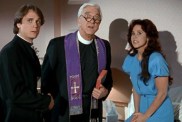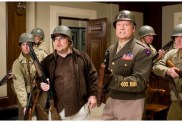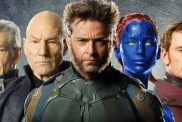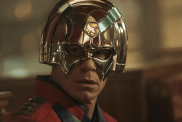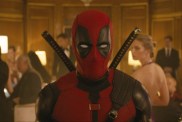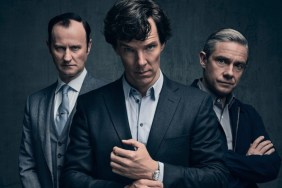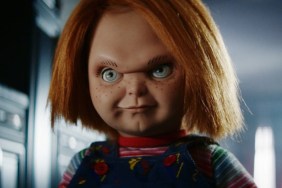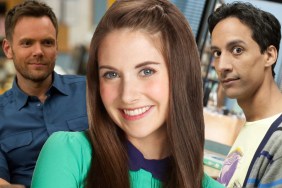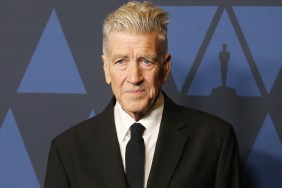If you’ve ever been to Disneyland or Universal Studios, you’ll be familiar with the way techniques and artistry borrowed from the film industry are used to turn empty plots of land into incredible, themed worlds. While the skills and tricks used are the same, on most film sets in the 21st Century, the scale is much less grandiose. To keep costs down, the majority of productions build only sections of the sets you see in the finished film — often keeping supposedly contiguous parts of a set in separate soundstages — then tie them together with clever editing and post-production VFX.
In some ways, this practical reality strips away some of the romance of film production, because while these sets are often still impressive, the illusion they create is usually broken the moment one steps round a corner, and emerges into a car park.
Which is why, when ComingSoon.net ventured down to London’s Leavesden Studios for a visit to the set of Guy Ritchie’s forthcoming King Arthur: Legend of the Sword, we were so surprised to find ourselves standing in the centre of 6th Century London, on a set the size of a city block.
“This is the biggest film any of us have ever made,” explains producer Steve Clark-Hall, “I say any of us, Lionel, who did all the Harry Potter movies, this is kind of normal for him.”
RELATED: Learn the Legend of the Sword in the New King Arthur Trailer
From our perspective, surrounded by towering, medieval buildings that took nearly five months to construct, it’s hard to see how this could possibly be described as ‘normal.’ It’s not so much the sets that are impressive, as it is the scale of the production, because in addition to the buildings, everywhere we look there are armour-clad background actors and stunt performers, milling around, waiting for a take. And this, we’re led to believe, is one of the relatively quiet days.
“When you have three or four hundred extras on a period movie, it’s a big deal getting them ready,” Clark-Hall explains. “They get their makeup done, their hair and all that. We have to process maybe three hundred, three hundred and fifty people through here in an hour and a half. We have a lot of what are called ‘dailies’ come in, daily makeup and costume people.”
And it’s not just wardrobe and makeup personnel who are needed when working with a cast that numbers in the hundreds, but, according to costume designer Annie Symons, a small army of fabricators as well.
“They’ve all broken up and gone now, but at full strength of it we had 250 people hammering and welding and gluing and cutting. It was like a medieval village out there with all the different crafts, which was amazing.“
These fabricators worked on creating the armour for the Blacklegs – the black-clad enforcers terrorising the English countryside on behalf of Jude Law’s villainous Vortigern.
“The armour’s a lot of fun to make, it’s fantastically interesting and difficult, because you have to articulate them, so there’s the engineering.” Symons continues, “We’ve made it all here, which is the incredible thing, we’ve made it all here, which is phenomenal, actually.”

In one of the Studios’ office buildings, production designer Gemma Jackson shows us a model of her set for Londinium — London about two centuries after the Romans left Britain — and talks us through some of the key elements. It’s only when we see the miniature that features the layout, and the sheer size of the set becomes clear.
“We tried to make it different feelings, so you get down town forums, and timber falling into the water and stuff like that. Some key things happen in those buildings,“ explains Jackson, gesturing to several structures in her model. “Then we come to the temple where people hang about on the steps, and generally just a show of the beauty that was there, and is dilapidated. Then there’s a lot that happened in the bath house, both inside and outside – that’s a pretty major set that one.”
She gestures to two more structures on her model, “And then these two buildings here, this was more of a dressing, but had to be there, because you’ve got to create angles, running places, lots of chases, you can imagine, so you have to create these areas.”
The areas she’s speaking about are two of several spaces in the ‘town’ created to facilitate filming chase and fight sequences. Aiden Gillen (Game of Thrones), who plays Goosefat Bill, a member of Arthur’s retinue, explains how these work during filming. “If you’re doing a chase scene, there’s always another alley that you can just run up, and it does happen like that.”
Indeed, according to Gillen, the sprawling set, combined with Ritchie’s flexibility as a director, allows for a great deal of spontaneity during the shoot. “The stunt guys run all the actors through a number of moves and little fight sequences, which may or may not get used.” The actor reveals, “Most of them get thrown out, because on the day it doesn’t fit the geography of the place, but there will be something else that will just be cobbled up on the spot to do with – ‘Why don’t we use that alleyway?’, ‘Why doesn’t somebody jump off that roof?’, ‘Why doesn’t somebody start firing arrows off that turret?’ It really is a proper, working city almost.”
One thing to be clear on here, is that while the King Arthur is set around 600AD, it is very much a fantasy movie, and as such, the level of historical accuracy is somewhat limited. As writer-producer Lionel Wigram puts it, “really, our period is a fairy tale period, it’s a magical period. It’s not any specific historical period, it’s not meant to be that, it’s meant to be an imaginary world inspired by certain historical realities.”
Indeed, when it comes to costume design, the styles are definitely not 7th Century, but much later, as Annie Symons explains. “In terms of period this lies all over the place, because it’s fantasy, we can do what we like, but it kind of swerves merrily between 12th and 14th Century.”
That being said, it’s not a completely haphazard affair. “I love the internal logic of all of this.” She continues, “It really matters to me that it works in the world that we’ve created.”
The situation was similar for Jackson’s meticulous research for the design of the production. “I went to all sorts of places. And you do find out that there’s a temple left in Colchester [the oldest town in Britain], and there’s a bit of a Roman bath in Bath, as we all know, so there are things around left to prove that stuff did exist and survive. And then after that you have to chuck your notes away, and just make your world the world of the movie.”
And while spending months researching the historical reality, only to chuck your notes away, might seem like madness to the rest of us, but to Jackson it makes perfect sense. “We’ve really worked to make it as real and visceral as possible. So although it’s a mad — we’ve got a 300ft elephant, it’s all kind of nuts — in my opinion, you have to make a really rock-solid base, and then you can do anything. Somehow, I think that it’s much more believable when it’s solid and real.”

For Wigram, who has “worked on various different Arthur projects over the years,” ignoring historical setting is only fitting, as he believes the original stories to be “a piece of propaganda,” aimed at veteran soldiers returning from overseas conflict, “Imagine in the 13th and 14th Century, there were all these knights and nobles who were warriors. Their main job in life is to go to war and win territory, and that’s how they get rich. Now they’re back at home, in time of peace, what do you with them? What are they supposed to do with themselves? How do you stop them fighting amongst each other? Really it’s about that.”
In addition to the Londinium set, the team also built a sizeable chunk of Camelot castle on the backlot, including a 300ft long bridge complete with four working ballistas — giant crossbows used for siege warfare — that according to weapons master Tim Wildgoose are “built exactly as they would have been built in the day,“ and “can fire 400ft.”
What is remarkable about this is that these practical elements represent only a portion of what we’ll see on screen, as they will end up being augmented with VFX work in the finished movie.
“It’s a massive visual effects movie, and a lot of it is going to have to do with how good the rendering of the visual effects are,” Wigram reveals when asked whether there is anything they would like to have done during filming, but were unable to achieve. “We have one of the best, if not the best, visual effects supervisors in the world. I’m confident that we’ll get there, but I think that’s the area. I would say in terms of our ambition for the story, and for the characters, we have surpassed our hopes and expectations.”
As any Englishman will tell you, this sort of scale and ambition is only fitting, given the cultural importance of the story the team are telling. “King Arthur was one of the most important stories ever told, for various thematic reasons.” Wigram continues, “since Excalibur, which was great fun in its day, there hasn’t really been a fun, fantasy adventure, big event version of this. King Arthur is a fairy tale, there should be monsters, there should be magic, and so we wanted to deliver that, because that’s the King Arthur we want to see.”
One the key elements of the Arthur mythos, perhaps the one element that even those unfamiliar with the stories can recall is the Sword in the Stone: Arthur’s weapon, Excalibur. The task of designing the most famous blade in English folklore fell to Tim Wildgoose. “It’s a dream job,” he confides, when asked whether he was intimidated by the challenge. “It was very good fun. That was the one that took the longest out of all of them for the design and making process, because we must have spent two or three months from starting to finish it. We didn’t finish it until about a week before we started shooting. It was a constant process of drawing, then we ran it past Guy, he picked this things he liked.”
“With a sword, there’s a lot of ergonomic feel to it, the way it feels in your hand, the weight of it and the look of it in a hand,” Wildgoose continues, “We went through many iterations of building the sword as well. We got to a certain point where we thought we liked it, then threw that one out and started again, pretty much on what ended up being the finished Excalibur that you see.”
Of course, a sword is nothing without someone to wield it, and the someone in question is Charlie Hunnam. How did it feel to be cast as the quintessential English leader? “One of my favourite films, that actually led me to want to become an actor, was Excalibur. I watched Excalibur ad nauseum as a child. So I’m very familiar with the world,” Hunnam reveals, as he explains the way he worked to develop this new incarnation of Arthur. “I’d read The Once and Future King years ago, and I’ve always loved this world. But I decided to just try to forget everything I’d ever seen, and just come in with it fresh, and not feel that pressure of having to do justice to this beloved story. It just felt like it was much healthier and more fun and more exciting and more free just to approach it as though it was a completely original story and a completely original character.”

Indeed for Hunnam, playing a character he’d been a fan of since childhood wasn’t the only unusual experience while working on the movie. Director, Guy Ritchie has been somewhat experimental with his style over the last few years, moving from gritty British crime flicks, to the steampunk Sherlock Holmes franchise, and most recently working on super-slick ’60s spy romp, The Man From UNCLE. With King Arthur, the director hasn’t only tweaked his style, but experimented with a new directing technique – shooting a dry run of the entire movie during the rehearsal period, as Hunnam explains:
“We did something strange and wonderful. I didn’t think it was gonna work at all, but it did. Guy had this wacky idea that he wanted to take an afternoon before we started working and shoot the whole film in four hours. On two or three cameras and in a room all in black. We shot the whole film, and that’s where we met. That’s where most of the cast met. It was a baptism of fire. It was such a high-energy, sort of anxiety-inducing experience.
“I think there were several elements as to why it was useful to him. First and foremost it was sort of like a table read, but where he could actually see everything edited. Sort of like an elevated table read. Just to see the pace and the tone and a little bit of the dynamics between the characters. So that was the pre-production benefit of it. As we’ve gone on and they’ve been assembling different sequences that we’ve been shooting, we’ve been able to fill in the gaps with that stuff. So from about halfway into the filming, they’ve had the whole film sort of edited with those sections that we hadn’t shot yet filled in with that four-hour thing. Which has been really interesting and helpful to Guy. He’s been going back and rewatching the film quite a lot. I’m sure if you talk to him there would have been other benefits too. But they were the obvious big ones.”
While Hunnam describes the majority of the scenes they’ve shot as “kind of a straight, character-driven drama,” by the time we got to set, the production had been rolling for several months, and the team were going in to the last few weeks of filming – which involved three solid weeks of action sequences.
“There’s been some very, very tricky pieces because of the process,” he explains. “There’s a bit of different-speed stuff going on, slow motion and real-time happening simultaneously on screen, which I don’t know has really been done before, certainly not the way we’re doing it or the way that Guy’s doing it. So those sequences have to be shot separately and laid over each other. I had a lot of sequences where there was very intricate swordplay. But I was fighting imaginary foes that couldn’t be anybody, because I was moving at a different speed. So that was a very tricky sequence to shoot — fighting, being in the right position, and having the right placement to fight eight or nine people in a row when there was nobody there. So that was a real challenge.”
While it may seem like the fun and exciting part of the job when it’s cut together on screen, filming action sequences is especially taxing for an actor. In addition to embodying a character, the performer is required to follow a strictly choreographed sequence of movements, hitting their marks every time they do so. It’s a hugely technical exercise, and one few can carry off convincingly. One of the ways Hunnam manages to do this is to reduce the number of elements that can go wrong by doing press-ups, and running on the spot between takes, Asked about why he did this, he gives context for the scene. “This comes at the end of a very long, lone-survivor-esque survival sequence, where we’re getting chased and smashed and falling off of buildings.” Before going on to explain, “So I feel like anything that reduces the necessity to act… So if you have to be out of breath, just make yourself out of breath. Then that’s one less thing to worry about while the camera’s rolling. It’s as simple as that.”
And while exercising before a take is a small element that adds to a performance, for Hunnam, the real key to embodying Arthur comes from the wealth of practical elements that surround him every day. ”If you look at these sets, as much as possible we’ll do in real time, and there’s real stunts going on. I think there’s a creative texture to it, because you can do everything CG now. But f*ck, why?! Why do that when you can do it for real, you know? Because I always think it’s gonna be better.”
“I think it informs your relationship with your surroundings if you actually have surroundings,” he explains. “Especially in environments that you’re supposed to be familiar with, I always like to come in and walk around and get a bit familiar. So when there’s a lull, there’s some activity to be done, because you’re interacting with the environment as opposed to saying, ‘Can I stand here or is this a f*cking robot?’”
King Arthur: Legend of the Sword opens in theaters on May 12, 2017.

